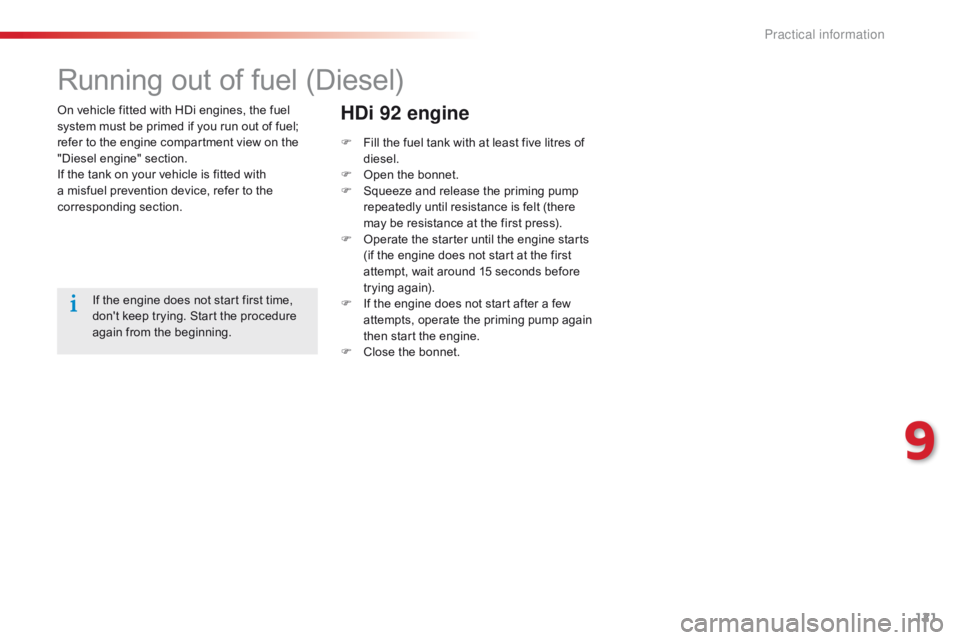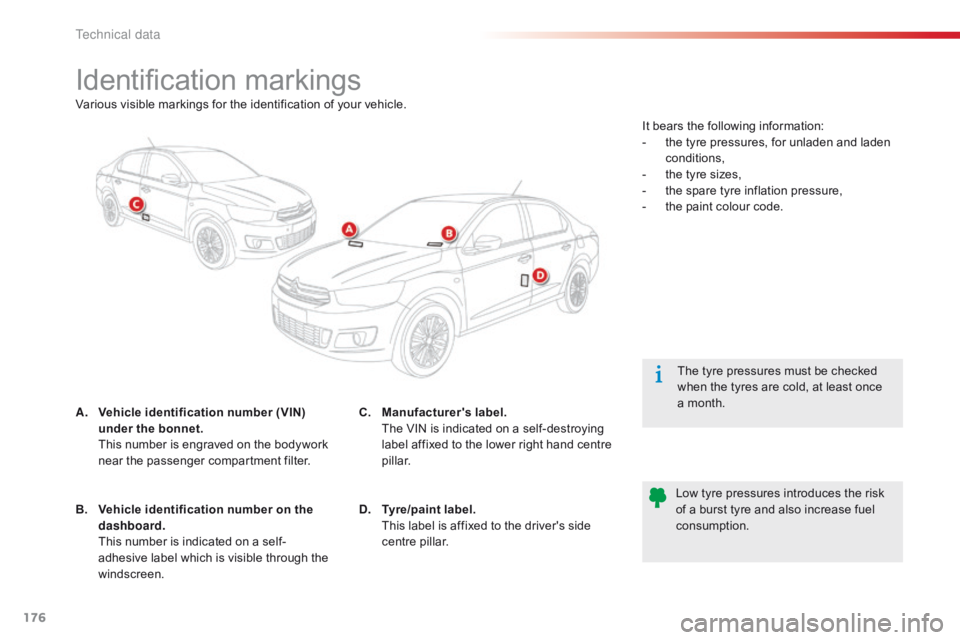fuel CITROEN C-ELYSÉE 2016 Handbook (in English)
[x] Cancel search | Manufacturer: CITROEN, Model Year: 2016, Model line: C-ELYSÉE, Model: CITROEN C-ELYSÉE 2016Pages: 330, PDF Size: 19.96 MB
Page 93 of 330

91
C-Elysee_en_Chap07_securite_ed01-2014
Under-inflation detection
The under-inflation detection system
does not replace the vigilance or the
responsibility of the driver.
This system does not avoid the need to
check the tyre pressures (including the
spare wheel) every month as well as
before a long journey.
Driving with under-inflated tyres impairs
road holding, extends braking distances
and causes premature tyre wear,
particularly under arduous condition
(high loading, high speed, long journey).The inflation pressures defined for
your vehicle can be found on the tyre
pressure label.
See the "Identification markings"
section.
Tyre pressures should be checked
when the tyres are "cold" (vehicle
stopped for 1 hour or after a journey of
less than 6 miles (10 km) at moderate
speeds).
Other wise (when hot), add 0.3 bar to
the pressures shown on the label.
Driving with under-inflated tyres
increases fuel consumption.
System which automatically checks the pressures of the tyres while driving.
The system monitors the pressures in the four
tyres, once the vehicle is moving.
It compares the information given by the four
wheel speed sensors with reference values,
which must be reinitialised ever y time the
tyre pressures are adjusted or a wheel
changed
.
The system triggers an alert as soon as it
detects a drop in the inflation pressure of one
or more tyres.
7
S
Page 120 of 330

118
Low fuel level
When the low fuel level in the tank is
reached, this warning lamp comes
on in the instrument panel.Opening the filler cap may result in an
inrush of air. This vacuum is entirely
normal and results from the sealing of
the fuel system.
Fuel tank
Capacity of the tank: approximately 50 litres. A label on the inside of the filler flap reminds
you of the type of fuel to use according to your
engine.
Additions of fuel must be of at least 5 litres to
be registered by the fuel gauge.
Refuelling
F Open the filler cap by turning it a 1/4 turn to the left.
F
R
emove the filler cap and hang it on its
carrier (on the filler flap).
F
F
ill the tank. Do not continue past the third
cut-off of the nozzle, as this may cause
malfunctions.
F
R
efit the filler cap turning it a 1/4 turn to the
right.
F
P
ush the filler flap to close it.Opening
F Raise the lever. When it first comes on, around 5 litres of fuel
remain in the tank.
You must refuel as soon as possible to avoid
running out.
If you run out of fuel (Diesel), refer the the
"Checks" section.
Practical information
Page 121 of 330

119
Operation
When a petrol filler nozzle is introduced into the
fuel filler neck of your Diesel vehicle, it comes
into contact with the flap. The system remains
closed and prevents filling.
Do not persist but introduce a Diesel type
filler nozzle.
Misfuel prevention (Diesel)*Mechanical device which prevents filling the tank of a Diesel vehicle with petrol. It avoids the risk of
engine damage that can result from filling with the wrong fuel.
Located in the filler neck, the misfuel prevention device appears when the filler cap is removed.
* According to country of sale.It remains possible to use a fuel can to
fill the tank.
In order to ensure a good flow of fuel,
do not place the nozzle of the fuel can
in direct contact with the flap of the
misfuel prevention device and pour
s l ow l y.
Travelling abroad
As Diesel fuel pump nozzles may
be different in other countries, the
presence of the misfuel prevention
device may make refuelling impossible.
Before travelling abroad, we
recommend that you check with the
CITROËN dealer network, whether your
vehicle is suitable for the fuel pumps in
the country in which you want to travel.
If you have put in the wrong fuel for
your vehicle, you must have have
the tank drained and refilled with
the correct fuel before you star t the
engine.
Fuel supply cut-off
Your vehicle is fitted with a safety system that
cuts off the supply of fuel in the event of an
impact.
9
Practical information
Page 122 of 330

120
Fuel used for petrol
engines
The petrol engines are compatible with
E10 bio-petrol (containing 10 % ethanol),
conforming to European standards EN 228 and
EN 15376.
E85 type fuels (containing up to 85 % ethanol)
are reserved exclusively for vehicles marketed
for the use of this type of fuel (BioFlex
vehicles). The quality of the ethanol must
comply with European standard EN 15293.
Fuel used for Diesel
engines
The Diesel engines are compatible with
biofuels which conform to current and future
European standards (Diesel fuel which
complies with standard EN 590 mixed with
a biofuel which complies with standard
EN
14214) available at the pumps (containing
up to 7 % Fatty Acid Methyl Ester).
B30 biofuel can be used in certain Diesel
engines. However, this use, even occasional,
requires strict application of the special
servicing conditions. Contact a CITROËN
dealer or a qualified workshop.
The use of any other type of (bio)fuel
(vegetable or animal oils, pure or diluted,
domestic fuel...) is strictly prohibited (risk of
damage to the engine and fuel system).
Practical information
Page 123 of 330

121
On vehicle fitted with HDi engines, the fuel
system must be primed if you run out of fuel;
refer to the engine compartment view on the
"Diesel engine" section.
If the tank on your vehicle is fitted with
a misfuel prevention device, refer to the
corresponding section.
Running out of fuel (Diesel)
If the engine does not start first time,
don't keep trying. Start the procedure
again from the beginning.F
F
ill the fuel tank with at least five litres of
diesel.
F
O
pen the bonnet.
F
S
queeze and release the priming pump
repeatedly until resistance is felt (there
may be resistance at the first press).
F
O
perate the starter until the engine starts
(if the engine does not start at the first
attempt, wait around 15 seconds before
trying again).
F I f the engine does not start after a few
attempts, operate the priming pump again
then start the engine.
F
C
lose the bonnet.
HDi 92 engine
9
Practical information
Page 173 of 330

171
EngineVTi 72 VTi 115
Gearbox Manual
(5-speed) Electronic
(5-speed) Manual
(5-speed) Automatic
(4-speed)
Model code: DD... HMY0HMY0/P NFP0NFP9
Cubic capacity (cc) 1 1991 587
Bore x stroke (mm) 75 x 90.578.5 x 82
Max power: EU standard (kW)* 5385
Max power engine speed (rpm) 5 5006 050
Max torque: EU standard (Nm) 11 0150
Max torque engine speed (rpm) 3 0004 000
Fuel Unleaded 91 RON to 98 RONUnleaded 91 RON to 98 RON
Catalytic converter yesyes
Engine oil capacity in litres (with filter
replacement) 3.25
3.5
Petrol engines
* The maximum power corresponds to the value type approved on a test bed, under conditions defined by European legislation
(Directive 1 999/99/EC).
11
Technical data
Page 175 of 330

173
EngineHDi 92
Gearbox Manual
(5-speed)
Model code: DD... 9HJC9HP0
Cubic capacity (cc) 1 560
Bore x stroke (mm) 75 x 88
Max power: EU standard (kW)* 68
Max power engine speed (rpm) 4 000
Max torque: EU standard (Nm) 230
Max torque engine speed (rpm) 1 750
Fuel
die
sel
Catalytic converter yes
Particle filter noyes
Engine oil capcity in litres (with filter
replacement) 3.75
Diesel engine
* The maximum power corresponds to the value type approved on a test bed, under conditions defined by European legislation
(Directive 1 999/99/EC).
11
Technical data
Page 178 of 330

176
Identification markings
A. Vehicle identification number (VIN) under the bonnet.
T
his number is engraved on the bodywork
near the passenger compartment filter. The tyre pressures must be checked
when the tyres are cold, at least once
a month.
Low tyre pressures introduces the risk
of a burst tyre and also increase fuel
consumption.
B.
V
ehicle identification number on the
dashboard.
T
his number is indicated on a self-
adhesive label which is visible through the
windscreen. C. M
anufacturer's label. T
he VIN is indicated on a self-destroying
label affixed to the lower right hand centre
pillar.
D.
T
yre/paint label.
T
his label is affixed to the driver's side
centre pillar. It bears the following information:
-
t
he tyre pressures, for unladen and laden
conditions,
-
t
he tyre sizes,
-
t
he spare tyre inflation pressure,
-
t
he paint colour code.
Various visible markings for the identification of your vehicle.
Technical data
Page 226 of 330

224
Exterior
Remote control key 30 -33
- o pening / closing
-
a
nti-theft protection
-
s
tarting
-
b
attery
Boot
3
7-38
-
o
pening / closing
-
em
ergency release
Temporary puncture
repair kit
1
22-127
Wipers
87
- 88
Changing a wiper blade
1
51
Changing bulbs
1
40-141
-
r
ear lamps
-
3rd brake lamp
-
n
umber plate lamps
-
fo
glamp
Fuel tank, misfuel prevention
1
18-120
Running out of fuel (Diesel)
1
21
Accessories
1
57-158
ESP/ASR
9
5
Tyre pressures
1
76
Changing a wheel
1
28 -134
-
t
ools
-
r
emoving / refitting
Snow chains
1
35
Under-inflation detection
9
1-93
Lighting controls
8
1- 85
Daytime running lamps
8
5
Headlamp beam adjustment
8
6
Changing bulbs
1
36-139
-
f
ront lamps
-
fo
glamps
-
d
irection indicator repeaters
Towing
15
2-153
Very cold climate screen(s)
1
56
Door mirrors
4
3 - 44
Doors
3
0 -33, 36
-
o
pening / closing
-
c
entral locking
-
s
econdary control
Alarm
3
4-35
Electric windows
3
9 Rear parking sensors
7
9 - 80
To w b a r
1
5 4
Visual search
Page 230 of 330

228
Maintenance - Technical data
Petrol weights 172
Diesel weights 1 74
Changing bulbs
1
36-141
-
f
ront
-
r
ear Running out of fuel, Diesel
1
21
Opening the bonnet
1
62
Under the bonnet, petrol
1
63
Under the bonnet, Diesel
1
64
Petrol engines
1
71
Diesel engines
1
73 Bat ter y
14
7-149
Load reduction, economy mode
1
49, 150
Engine compartment
fuses
14
2-143, 146
Checking levels
1
65 -168
-
o
il
-
b
rake fluid
-
c
oolant
-
s
creenwash fluid
-
a
dditive (Diesel with particle filter)
Checking components
1
69 -170
-
b
attery
-
a
ir / passenger compartment filter
-
o
il filter
-
p
article filter (Diesel)
-
b
rake pads / discs
Identification markings
1
76
Dimensions
1
75
Visual search